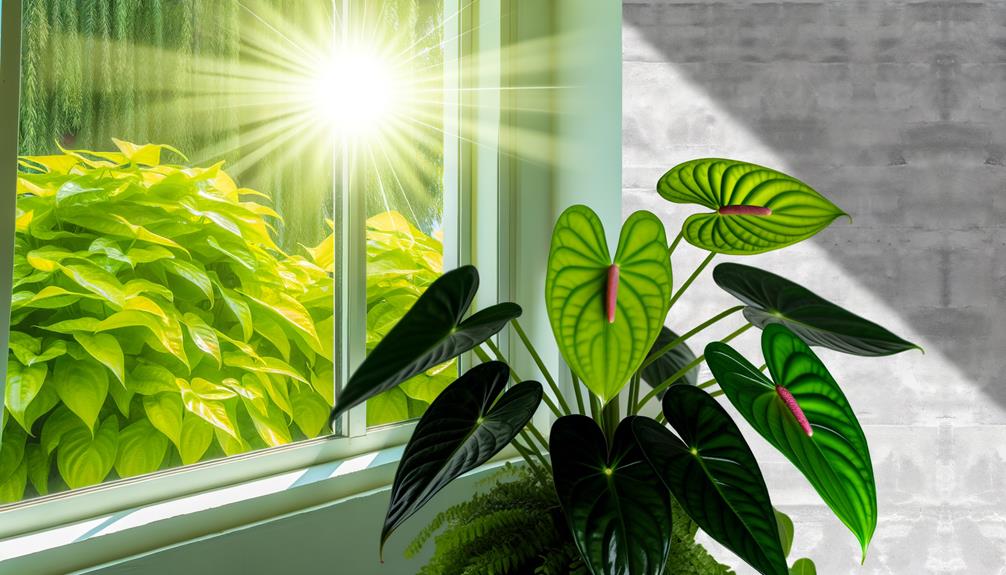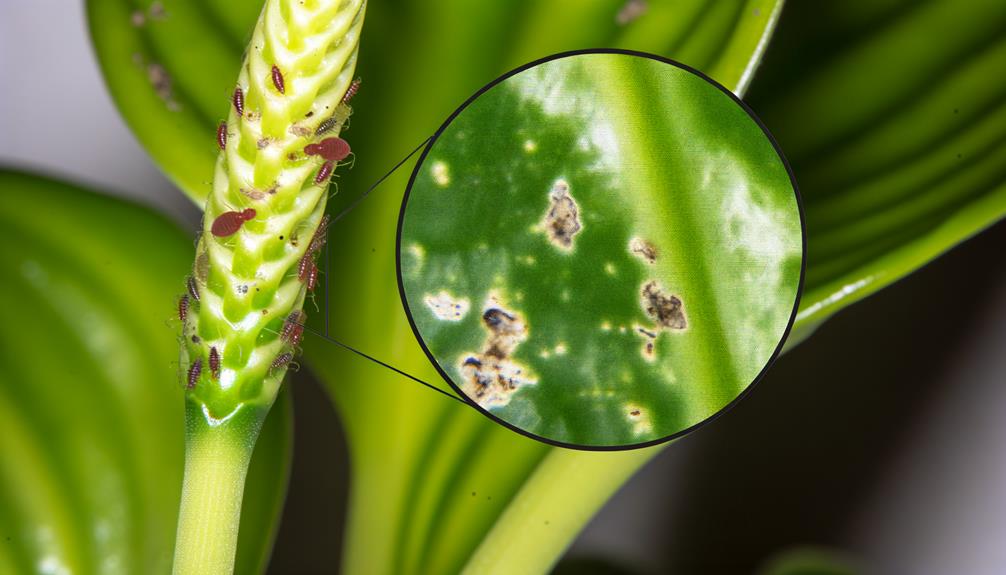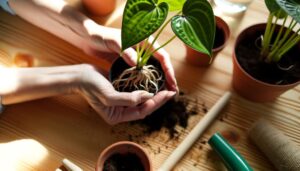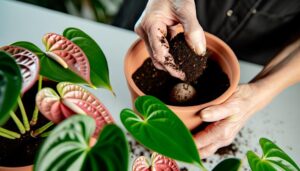Birds Nest Anthurium Care – A Complete How-To Guide
For prime care of your Bird’s Nest Anthurium, position it in bright, indirect light to mirror its native habitat. Water consistently with room-temperature water, ensuring the top inch of soil stays damp and the pot has good drainage.
Use a well-aerated potting mix with peat moss, perlite, and pine bark, maintaining a pH of 5.5 to 6.5. Fertilize with a diluted 20-20-20 balanced, water-soluble fertilizer, except during winter dormancy.
Inspect regularly for pests like aphids and mealybugs, and use insecticidal soap or neem oil as needed. Discover more intricate details and expert tips as you proceed.

Key Takeaways
- Place your Birds Nest Anthurium in bright, indirect light, avoiding direct sunlight.
- Maintain consistently moist soil by checking the top inch for dryness before watering.
- Use a well-ventilated, fast-draining potting mix with peat moss, perlite, and pine bark.
- Fertilize with a balanced, water-soluble fertilizer diluted to half strength, avoiding winter months.
- Regularly inspect for pests like aphids and spider mites, and treat infestations with insecticidal soap or neem oil.
Ideal Lighting Conditions

To maximize growth, position your Bird’s Nest Anthurium in bright, indirect light, avoiding direct sunlight which can scorch its leaves. This tropical plant thrives in an environment that mimics the dappled light of its native forest floor.
Place it near an east or north-facing window, where it can receive ample filtered light. If natural light is insufficient, consider using fluorescent grow lights to supplement.
Monitor the plant’s leaves for signs of inadequate lighting, such as leggy growth or pale, yellowish foliage. Adjust the position as needed to ensure ideal light exposure.
Watering Guidelines
When watering your Bird’s Nest Anthurium, make certain the soil remains consistently moist but not waterlogged to prevent root rot and promote healthy growth.
Use room-temperature water and apply it evenly across the soil surface. Check the top inch of soil; if it feels dry, it’s time to water.
During active growth phases, typically spring and summer, increase the frequency of watering slightly. In contrast, reduce watering during the plant’s dormant period in fall and winter.
Always make sure proper drainage by emptying the saucer beneath the pot after watering to avoid stagnant water.
Monitoring the humidity levels around the plant, ideally keeping it between 60-80%, can also help maintain the plant’s water needs efficiently.
Soil Preferences

For best development, your Bird’s Nest Anthurium thrives in a well-ventilated, fast-draining potting mix rich in organic matter.
Utilize a blend that includes peat moss, perlite, and pine bark. This combination guarantees sufficient aeration and moisture retention without waterlogging the roots.
You should aim for a pH level between 5.5 and 6.5, which promotes optimal nutrient absorption. When preparing the mix, sterilize all components to eliminate pathogens. Avoid using dense garden soil, which can compress and hinder root respiration.
Repotting every 2-3 years helps refresh the soil and prevents root-bound conditions. Always make sure the container has drainage holes to facilitate excess water escape, maintaining the delicate balance of moisture and ventilation essential for your Anthurium.
Fertilizing Tips
Feeding your Bird’s Nest Anthurium with a balanced, water-soluble fertilizer every 6-8 weeks during the growing season promotes robust growth and vibrant foliage.
Choose a fertilizer with an N-P-K ratio of 20-20-20 or similar. Dilute the fertilizer to half the recommended strength to avoid nutrient burn.
Apply the solution evenly around the base of the plant, making sure it penetrates the soil. Avoid fertilizing during the dormant winter months, as the plant’s nutrient uptake is minimal. Monitor for signs of over-fertilization, such as leaf burn or salt buildup on the soil surface.
Leach the soil periodically by flushing with water to prevent salt accumulation. This routine guarantees your Anthurium thrives, enhancing its beauty and health.
Common Pests and Diseases

Regularly inspecting your Bird’s Nest Anthurium for common pests and diseases will help you quickly identify and address issues to maintain the plant’s health.
Look for aphids, mealybugs, and spider mites on the undersides of leaves. Use insecticidal soap or neem oil to treat infestations.
Check for signs of root rot, such as yellowing leaves and mushy roots, by ensuring the plant isn’t overwatered and has well-draining soil.
To prevent bacterial blight, characterized by water-soaked lesions on leaves, maintain proper humidity and avoid overhead watering. Immediately remove and destroy infected plant parts.
Conclusion
Caring for your Bird’s Nest Anthurium is straightforward with the right knowledge. Follow these guidelines for success:
provide indirect sunlight, keep the soil moist but not waterlogged, use a well-draining mix, and fertilize monthly.
For instance, Jane’s Anthurium thrived after she moved it to a spot with filtered light and adjusted her watering schedule.
Keep an eye out for pests and diseases to guarantee your plant stays healthy. With diligence, your Anthurium will flourish.






